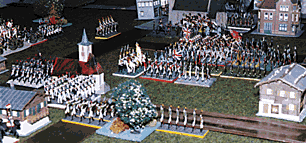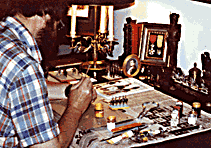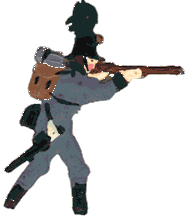
The generalization of a dichotomy of military miniatures into collectors and war-gamers is in fact contrived and illusory. For the collector, as for the war-gamer, war-games need not be colorless, mechanical, and devoid of that special romance which collectors are wont to possess. On the contrary, a war-game is the ultimate, exclusive indulgence which permits the fullest realization of that romance. Colorful uniforms are but part of the general panoply, but what emerges is a sum greater than its parts. War-gaming represents a combination of a skillful negotiation of tactics with the chival rous pageantry of color, romance, and style. What produces a successful war-game- in the larger sense is not merely the victory of one opponent over another. Like all games, it is the challenge presented between equal opponents, as well as the tempering of that challenge with a certain style. Style is that method of doing things which is in some way distinctive of the war-game group.
In the consideration of style, while victory remains the ultimate object, it is not the primary purpose for the war-game. Other things, more complicated to explain, except by example, go into a successful war-game.
 The spectacle of the war-game board to the war-gamer does not consist of lead figures mounted on placards or bases; it does not appear as cardboard or plastic buildings, paper rivers and roads, or plasticene hills or lichen trees however artfully conceived. From the beginning of the game until the last volley is fired, the multiple ingredients take on a great fantasy. In the eyes of the beholder, the square arrangement of blue figures which appears haphazardly in the din of battle represents more than lead and paint to the player. It is the last defiant and noble gesture of the French Garde Impériale at Waterloo, wreathed in smoke, covering them selves with glory and sacrificing themselves on the altar of the Empire. The single line of red in kilts, a line which perhaps stretches two feet across the battle-board, may represent the stub born pride of the Sutherland Highlanders containing the Russians at Inkerman while the pipers blast the acrid air with Scotland the Brave. The cluster of buildings at the crossroads appears as the imperial city of Vienna to the approaching blue columns, and the blue papered river by the forest conjures up the horrid visions of the crossing of the Beresina in 1812 in the retreat from Moscow. The versions may be different but the thoughts are the same. The participant is re-living and identifying with the most exciting moments of history. For that brief departure from reality, he has become a part of the panoply of grand gestures and heroics which characterized the Napoleonic age.
The spectacle of the war-game board to the war-gamer does not consist of lead figures mounted on placards or bases; it does not appear as cardboard or plastic buildings, paper rivers and roads, or plasticene hills or lichen trees however artfully conceived. From the beginning of the game until the last volley is fired, the multiple ingredients take on a great fantasy. In the eyes of the beholder, the square arrangement of blue figures which appears haphazardly in the din of battle represents more than lead and paint to the player. It is the last defiant and noble gesture of the French Garde Impériale at Waterloo, wreathed in smoke, covering them selves with glory and sacrificing themselves on the altar of the Empire. The single line of red in kilts, a line which perhaps stretches two feet across the battle-board, may represent the stub born pride of the Sutherland Highlanders containing the Russians at Inkerman while the pipers blast the acrid air with Scotland the Brave. The cluster of buildings at the crossroads appears as the imperial city of Vienna to the approaching blue columns, and the blue papered river by the forest conjures up the horrid visions of the crossing of the Beresina in 1812 in the retreat from Moscow. The versions may be different but the thoughts are the same. The participant is re-living and identifying with the most exciting moments of history. For that brief departure from reality, he has become a part of the panoply of grand gestures and heroics which characterized the Napoleonic age.The visions of vainglory which flash before his eyes emanate from his mind's extravagant imagination. To the degree which a gamer can call a war-game "successful'' then, depends to a great extent on how closely he identifies with the figures on the board, and with the staff which commands them, and to some persons, even with the nationalistic aspirations and political considerations which depend on the tateful battle.
 The beauty of the formations has as much to do with this identity as the beauty of the execution of their movement in battle. Many war-gamers take great pride in the workmanship of the details which appear on their game figures. Such details as straps, buttons, and shading cannot be appreciated from an ordinary eye level and can hardly be distinguished trom a less detailed figure at the same level. But some how it does seem to matter to the war-gamer for he attaches a special significance to his corps d'elite. That is, he identifies more closely with it, and its fate, or success, in the game becomes his own. The paint work on a war-game figure is as important to the morale of the gamer as esprit-de-corps can be to an army. This pride of manufacture, of authenticity, is not reduced by reverses in the field. A defeat by out maneuvering or fire power can never diminish the war-gamer's enthusiasm for this unit.
The beauty of the formations has as much to do with this identity as the beauty of the execution of their movement in battle. Many war-gamers take great pride in the workmanship of the details which appear on their game figures. Such details as straps, buttons, and shading cannot be appreciated from an ordinary eye level and can hardly be distinguished trom a less detailed figure at the same level. But some how it does seem to matter to the war-gamer for he attaches a special significance to his corps d'elite. That is, he identifies more closely with it, and its fate, or success, in the game becomes his own. The paint work on a war-game figure is as important to the morale of the gamer as esprit-de-corps can be to an army. This pride of manufacture, of authenticity, is not reduced by reverses in the field. A defeat by out maneuvering or fire power can never diminish the war-gamer's enthusiasm for this unit.Our group1 has been able to achieve considerable success in adding elements of style to war-gaming; 2 the bases upon which our figures are mounted conform to certain standards by general agreement. Firstly, the bases of the individual units are in the particular color which identifies their nationality: khaki for the French, grey tor the Russians, olive green for the Austrains, field green for the Prussians, and medium green for the British. Additionally, the edges of the bases reflect the status of the unit. The Guard regimental bases are trimmed in red, the Light Infantry in yellow, the Reserve in white, Guard sharpshooters in red/yellow striping, and the Line is plain. Colors also identity and differentiate heavy, light, and guard cavalry units. In a practical sense, the color code gives quick identification to the troops. In a larger sense, the beauty of the board is enhanced by standardization, order, and style. The bases may also record a division or corps' identification number, or may display battle decorations in a further effort at distinction.
In addition to paint work and base ornamentation, each army displays on special bases (which might be termed pedestals), a general staff, which may vary from a diorama of four figures to a suite of twelve. These prizes, as objects in a war-game, also represent symbolically the pride of an army. The individual war gamer competes for the envious glances of his companions-in-arms for the most beautiful display. Line staff are also represented on bases which identify, either by color or number, the organization of the corps d'armée.
Procedurely, prior to the actual war-game, diplomatic correspondance between participants is generally exchanged: proposing alliances, negotiating secret convenants, dividing spoils, or issuing ultimatums. Acts of diplomacy give some theoretical element to the game and make the battle relevant to a political situation, as every historian must realize it was. Then a geographical focus is chosen on a map where the battle is eventually to be engaged. The battle-board is carefully arranged to fit the topography of the map and each adversary care fully prepares a plan of strategy reducing it to writing without being aware of his enemy's intentions. The plan is based largely on the ability to take advantage of prominent features in the terrain (where flanks can be protected by rivers, forests, or hills), as well as the ability to anticipate where the foe will be. The adversaries are held to their plan in the initial disposition of troops, for good or no. After that, they are left to make the best of a bad situation or to exploit an oversight on the part of their opponent. Victory in a war-game can often be predicted in the first move, and many a player has discovered that his magnificent strategem for throwing his adversary off-balance in an offensive has rendered his position untenable in a defense. And as a consequence, hours have been employed with forced marches by troops left on the perimeter without a thing to do, while the objective is in peril of capture.
The use of dice may be decried by some as the dethroning of skill for chance, but skill in battle, as history so often discloses, is little more than the ability to profit from chance or opportunity. Dice presents the chance, general ship produces the opportunities for victory. Regardless, the war-gamer more often teels that he is left ultimately in the hand of fate than the Firing Table. But viewed as a more-or-less helpless pawn of the gods, war-gamers are less apt to involve their egos and injure their pride brought on by a too-close identification with history, personalities, and the course of the battle on the board. Style, itself, can both produce the identification essential to the success of the war-game, and prevent its abuse by over-involvement.
During the engagement, and in keeping with diplomatic convention, the host often serves "liquorous libations" of drink representative of the various nationalities present. At tlmes, unfortunately, certain individuals have in the past neglected their duties in the field showing instead a preference for the satisfaction of their thirst, with consequent results. But I have never known a war-game dispute, no matter how bitter, that wasn't settled over a good glass of Port. This little refreshment, even aside from its initial pleasantness, is a great tranquilizer tor the jagged nerves, and seems to put everything in the correct perspective, especially when war gamers are most apt to identity too closely with their causes. The strong fellowship among war-gamers which results from a mutual recognizance of a special and common interest in war-gaming should be at its closest bond at the end of the battle.
The war-game is generally conducted along the most professional lines similar to the diplomatic courtesies displayed between the warring monarchs in the past. Insults, of course, are exchanged. Toasts are often made to uncommon valor and splendid successes of particular units in the field. As a supreme grand geste, foreign units have been decorated by grateful allies for meritorious service. Applause frequently rings the excited air of conviviality. At times, fine cigars have been passed out atter a particular ''good show," and on at least one occasion atter a splendid French cavalry charge which reversed an impossible situation, cognac was served, even though the battle was still in doubt.
 At all times, as a backdrop to the battle, appropriate thematic music lends itself to this atmosphere of controlled conflict. Be it pipes and drums, Napoleonic marches, or the sound track from War and Peace. in all cases the music is relevant to the instant proceding. Far from dominating, it becomes stylistically just one more component part of a larger context. I believe it was Voltaire who said. ''Style make the man." What I have said so far is that "style makes the game.'' Style, that distinctive concern with manner that tempers and polishes our indulgences, adds appreciably to the success of war-games, Where some war-gamers are frought with ''combat fatigue'' and give way to the license of argument and conflict among themselves, the interjection of style smooths over these differences. and war-games become an excellent exercise in friendly challenge. For the war-gamer, the ''journey through the looking glass'' is not eftortless. But once achieved, stylistically through the development of skill, color, and an affinity tor people,. it becomes the most pleasant of pastimes.
At all times, as a backdrop to the battle, appropriate thematic music lends itself to this atmosphere of controlled conflict. Be it pipes and drums, Napoleonic marches, or the sound track from War and Peace. in all cases the music is relevant to the instant proceding. Far from dominating, it becomes stylistically just one more component part of a larger context. I believe it was Voltaire who said. ''Style make the man." What I have said so far is that "style makes the game.'' Style, that distinctive concern with manner that tempers and polishes our indulgences, adds appreciably to the success of war-games, Where some war-gamers are frought with ''combat fatigue'' and give way to the license of argument and conflict among themselves, the interjection of style smooths over these differences. and war-games become an excellent exercise in friendly challenge. For the war-gamer, the ''journey through the looking glass'' is not eftortless. But once achieved, stylistically through the development of skill, color, and an affinity tor people,. it becomes the most pleasant of pastimes.As each war-game group has essentially a different view of what is important to a war game, the results, the ingredients, and the rules will vary between them. What should not be missed, though, is the real opponunity present to exploit our imaginations to the fullest with what is in fact and tancy, an exceptionally envigorating hobby. If I have persuaded the purest collector to dabble or experiment in the excitement and enthusiasm of a war-game, I hope also to have reminded the maneuver-minded war-gamer of an appreciation for color and style, in mobilizing the component parts of his game in a form which greets all the senses in unfolding a faithful drama of military romance.
 1 The Société Napoléonienne.
1 The Société Napoléonienne.2 The Society restricts its war-games rather exclusively to the Napoleonic Wars, and to the use of "flats." As a rule, a regiment is made up of approximately eighteen men, mounted on three 1" x 3" bases, being six men per base. Cavalry regiments are composed of two bases of five men each.
This article was originally published in Campaigns magazine no. 10 (1977) as "Wargaming Can be Fun".

No comments:
Post a Comment